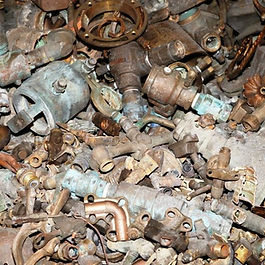Partial List of Materials We Accept

Aluminum Breakage
Breakage is a classification for mixed scrap aluminum containing significant amounts of non-aluminum contaminants, like iron, dirt, plastic, or oil, that make it difficult to process and reduce its overall aluminum content.
Priced lower because of these impurities, aluminum parts that are heavily contaminated with other materials.

Aluminum Radiator
aluminum radiator is a device, commonly used in vehicles to cool the engine or in homes for heating, that uses aluminum's excellent heat conductivity and lightweight properties to transfer heat away from a fluid.
Unlike traditional copper-brass radiators, aluminum radiators are lighter, require less water to operate effectively, and are highly corrosion-resistant

Battery (Auto)
Battery lead recycling is a process where end-of-life lead-acid batteries are collected, broken apart, and separated into their components: lead, plastic, and acid, which are then processed into raw materials for making new products, most notably new lead batteries, thereby creating a closed-loop system that conserves resources and reduces environmental harm.

Cast Aluminum
This is the process of collecting, sorting, and melting down discarded aluminum items made by pouring molten aluminum into a mold, to produce secondary aluminum that can be used in new products.
Common items include engine blocks, engine parts, kitchenware, patio furniture, and some types of automotive and construction components

6063 Aluminum
6063 is an architectural alloy known for its excellent extrusion properties, allowing it to be formed into complex shapes for applications like window and door frames, furniture, and signage. It offers superior corrosion resistance and a fine surface finish, but with lower strength than some other alloys like 6061, making it ideal when aesthetics and corrosion resistance are prioritized over high strength.

Copper #1
Different than "Shiny"
The copper must be clean-looking, unalloyed, and uncoated. It should be free from paint, solder, fittings, insulation, tarnish, and other attached metals. It must be at least 98% pure copper. Copper wire with a diameter of at least 1/16th of an inch that is clean and free of any coating.

Copper BB
Also known as "shiny"
The highest grade of copper scrap, defined as clean, unalloyed, and uncoated copper wire or cable that is at least 16-gauge thick and free of insulation, paint, and tarnish, exhibiting a characteristic shiny, reddish-orange appearance. It is at least 99% pure, with some sources stating it can reach 99.9%
It must be clean, unalloyed, and uncoated, with absolutely no insulation, tarnish, paint, or other impurities. It must be wire or cable, not copper pipes or other copper items. It typically needs to be at least 16-gauge thick to qualify.


















